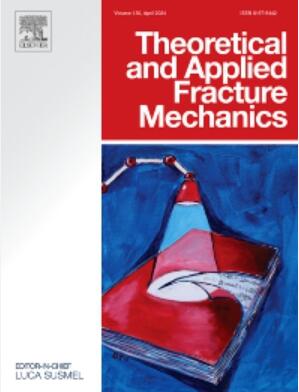Enhancing the fracture toughness of eco-friendly self-compacting concrete with waste glass coarse aggregates and steel fibers: A mixed-mode I/II fracture analysis using SCB specimens
IF 5
2区 工程技术
Q1 ENGINEERING, MECHANICAL
引用次数: 0
Abstract
Self-compacting concrete (SCC) has become increasingly significant in contemporary construction due to its excellent rheological characteristics and improved constructability. Nevertheless, its quasi-brittle nature and limited fracture toughness present notable challenges. This research explores the combined effects of utilizing waste glass coarse aggregates (WGCA) and hooked-end steel fibers (SFs) on the fracture behavior and mechanical properties of SCC subjected to complex loading scenarios. WGCA was incorporated to replace natural coarse aggregates (NCA) at replacement levels of 15 %, 30 %, and 45 %, while SFs were introduced at volume fractions of 0.1 %, 0.3 %, and 0.5 %. A total of 240 semi-circular bending (SCB) specimens were evaluated under four distinct loading modes (I, I/II, II/I, and II) after curing for 28 and 56 days, in addition to 60 cubic samples for assessing compressive strength. The findings indicate that substituting NCA with WGCA up to 30 % improves both fracture toughness and compressive strength, attributed to enhanced matrix densification resulting from the pozzolanic activity of glass particles. However, exceeding this percentage leads to a decline in performance due to inadequate bonding at the interface between the aggregate and matrix. The inclusion of SFs effectively addresses this limitation by improving crack-bridging mechanisms, stiffness, and ductility. The most favorable outcomes were observed with 30 % WGCA and 0.5 % SF, which provided exceptional resistance to crack propagation across all loading modes. This extensive study offers valuable insights into the sustainable use of WGCA and SFs in SCC, tackling both environmental and structural issues. The results highlight the potential benefits of integrating recycled materials and fiber reinforcement to enhance the performance of SCC under practical loading conditions.
废玻璃粗骨料和钢纤维增强生态友好型自密实混凝土的断裂韧性:使用SCB试样的混合模式I/II断裂分析
自密实混凝土(SCC)由于其优异的流变特性和改善的施工性能,在当代建筑中发挥着越来越重要的作用。然而,它的准脆性和有限的断裂韧性提出了显著的挑战。本研究探讨了利用废玻璃粗骨料(WGCA)和钩端钢纤维(SFs)对复杂加载情景下SCC断裂行为和力学性能的联合影响。在15%、30%和45%的替代水平下,加入WGCA替代天然粗骨料(NCA),而在0.1%、0.3%和0.5%的体积分数下引入SFs。在养护28天和56天后,对240个半圆弯曲(SCB)试件在I、I/II、II/I和II四种不同加载模式下进行了评估,并对60个立方试件进行了抗压强度评估。研究结果表明,用WGCA代替NCA可提高高达30%的断裂韧性和抗压强度,这是由于玻璃颗粒的火山灰活性增强了基体致密性。然而,超过这个百分比会导致性能下降,因为骨料和基体之间的界面粘合不足。通过改进裂缝弥合机制、刚度和延性,SFs的加入有效地解决了这一限制。最有利的结果是30%的WGCA和0.5%的SF,在所有加载模式下都提供了出色的抗裂纹扩展能力。这项广泛的研究为SCC中WGCA和SFs的可持续利用提供了有价值的见解,解决了环境和结构问题。研究结果强调了将再生材料与纤维增强相结合以提高SCC在实际荷载条件下的性能的潜在效益。
本文章由计算机程序翻译,如有差异,请以英文原文为准。
求助全文
约1分钟内获得全文
求助全文
来源期刊

Theoretical and Applied Fracture Mechanics
工程技术-工程:机械
CiteScore
8.40
自引率
18.90%
发文量
435
审稿时长
37 days
期刊介绍:
Theoretical and Applied Fracture Mechanics'' aims & scopes have been re-designed to cover both the theoretical, applied, and numerical aspects associated with those cracking related phenomena taking place, at a micro-, meso-, and macroscopic level, in materials/components/structures of any kind.
The journal aims to cover the cracking/mechanical behaviour of materials/components/structures in those situations involving both time-independent and time-dependent system of external forces/moments (such as, for instance, quasi-static, impulsive, impact, blasting, creep, contact, and fatigue loading). Since, under the above circumstances, the mechanical behaviour of cracked materials/components/structures is also affected by the environmental conditions, the journal would consider also those theoretical/experimental research works investigating the effect of external variables such as, for instance, the effect of corrosive environments as well as of high/low-temperature.
 求助内容:
求助内容: 应助结果提醒方式:
应助结果提醒方式:


